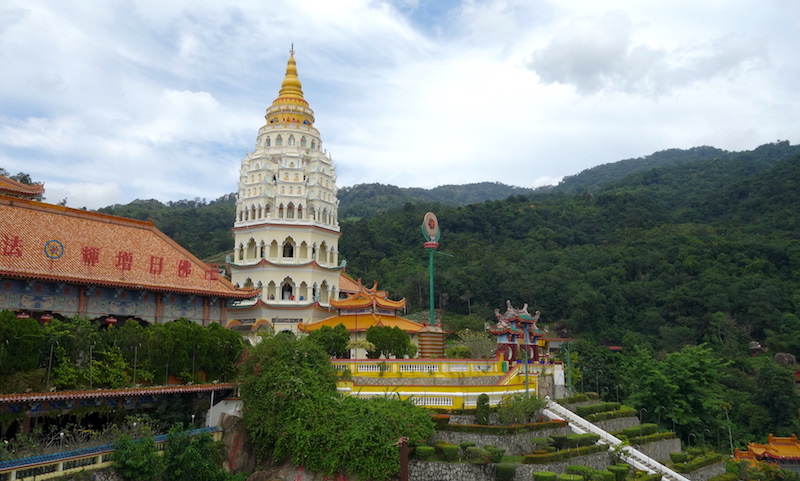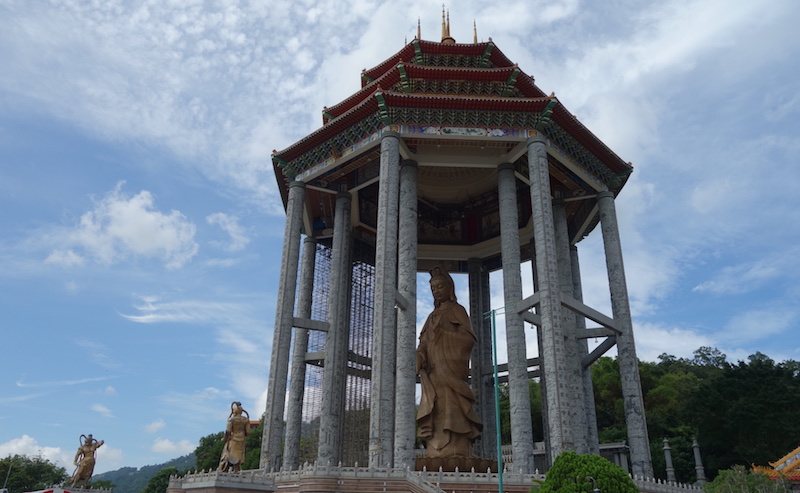Ayer Itam, Penang
After we got our visas, we moved to an Airbnb homestay in Ayer Itam (or Air Itam), closer to the center of the island and flanked by low mountains. The weather was just as hot, but the surroundings were calmer and greener. We were close to Kek Lok Si, probably the most famous Buddhist temple on Penang. It actually consists of an extensive complex of temples that extend up into the low mountains. It is known for its famous lofty pagoda tower featuring a combination of Burmese, Thai and Chinese Buddhist architectural styles.
 Pagoda tower at Kek Lok Si
Pagoda tower at Kek Lok Si
The complex also has a humongous statue of the goddess Guanyin (Kuan Yin, one of the bodhisattvas of Mahayana Buddhism).
 Guanyin statue tower at Kek Lok Si
Guanyin statue tower at Kek Lok Si
Ayer Itam is also close to Penang Hill, a park resort with a famously scenic view of George Town and the channel. To get up there you can either hike 1-2 hours or (like everyone) you take the somewhat historical railway (a funicular railway). The line for the train was endless, which is why some people pay double price (80 RM = $20, one way) to skip the line. We went late in the afternoon on a weekday and ended up waiting almost an hour to go up, and after the sunset waited over an hour to get down.
 View from Penang Hill
View from Penang Hill
Penang Food
Any description of Penang would incomplete without examining the food. But food is probably the main attraction to Penang for foreign tourists and other Malaysians. Compared to KL, Penang appeared to be more inhabited by Malaysians of Chinese descent and Hakka, with a smaller Muslim population than Kuala Lumpur. (Unlike in Kuala Lumpur and much of our time in Indonesia, we only rarely heard the Muslim call to prayer in Penang.) Along with those mentioned there is also the traditional Malaya influences, and a significant community of Malaysian Indians. All this makes for a delicious combination. Though KL is probably about as diverse something about Penang has brought more of these flavors out to commingle.
The best eating venues to experience the combination of tastes are at Hawker stalls — these are small vendors that prepare food at small 1-2 person kitchen stalls. They are usually grouped together in very informal settings (food courts, sidewalks, or alleyways) so you can sit in a common eating area while sampling dishes from a variety of Hawkers.
Here are some of the popular dishes we tried…
- assam laksa - heavy spicy sour fishy broth (made with shrimp paste and tamarind) with rice noodles and other various toppings
- hokkien mee - heavy spicy fishy broth (usually made with prawn shells, and ) often served with a combo of rice noodles and egg noodles and maybe some chunks of chicken and fish. Usually when it is served a soup spoon is placed in the bowl filled with fishy chili sauce so you can make it as spicy as you like
- char koay teow - flat noodles stir fried with sprouts and greens, and the specialty is to have it fried with duck egg
- popiah - like an un-fried spring roll with sweet jicama, tofu, chili sauce and a sweet soy sauce
- rojak - Do you like fruit, squid and chili pepper together? This one is for you — spicy, fishy, salty, and sour all at the same time. Mango, mountain apple, jicama, crispy fried tofu, squid topped with sauce made from palm sugar, peanuts, shrimp paste and sweet chili sauce. Not my favorite, but definitely worth trying.
Outside of Hawker stalls, an important component of Penang flavor can be found at Indian-Malaysian restaurants serving nasi kandar. This is basically buffet-style food of fish curries, mutton curries, korma, biryani, chana and some places had tasty chapati made right in front of us. Some intense flavors, much of it’s spicy, and most of it’s quite delicious.
But we were so busy enjoying all our food that we didn’t take any pictures of it.